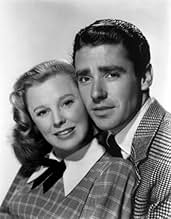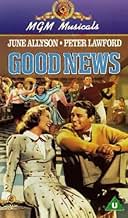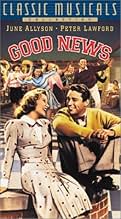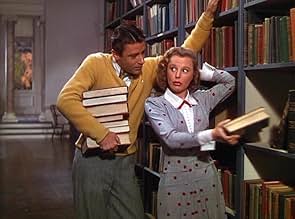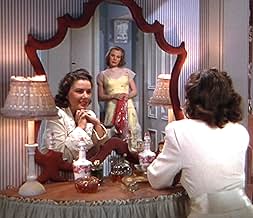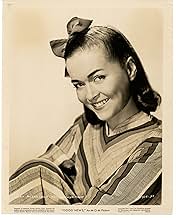IMDb RATING
6.7/10
2.9K
YOUR RATING
Golden Globe winner June Allyson and Peter Lawford star in this enjoyable musical about a football hero who falls in love with his French tutor.Golden Globe winner June Allyson and Peter Lawford star in this enjoyable musical about a football hero who falls in love with his French tutor.Golden Globe winner June Allyson and Peter Lawford star in this enjoyable musical about a football hero who falls in love with his French tutor.
- Nominated for 1 Oscar
- 1 nomination total
Robert E. Strickland
- Peter Van Dyne III
- (as Robert Strickland)
King Baggot
- Man at Coat Check Counter
- (uncredited)
William A. Boardway
- Dance Guest
- (uncredited)
Featured reviews
9tavm
Good News is one of the most underrated MGM musicals from the '40s I've ever seen from that era. While leads June Allyson and Peter Lawford are no Judy Garland and Mickey Rooney (who ironically, were the original considered leads for this movie version years ago), they sing and dance entertainingly enough for one to not notice after a while. Another underrated talent showcased here is one Joan McCracken who shines in the opening number and the later made-for-film specialty "Pass That Peace Pipe", which was eventually nominated for an Oscar for Best Original Song. And dig the "Velvet Fog" Mel Torme in his younger days crooning here! Excellent debut for director Charles Walters and screenwriters Betty Comden and Adolph Green makes this one of the most spectacular musical comedies I've seen yet! P.S. Among the extras on the DVD are two numbers from the 1930 film version of Good News, the title number and "The Varsity Drag", both performed energetically and athletically by a young woman named Dorothy McNulty, later to be known as Penny Singleton from the Blondie movies. All of the above are well worth checking out!
Good News was the best musical from the Roaring Twenties from the premier songwriting team of DeSylva,Brown&Henderson. It ran on Broadway for 557 performances in the 1927-29 season and gave the team a number of song hits identified with them like the title song, Just Imagine, Lucky In Love, and The Best Things In Life Are Free. All of those songs made it as well as one of the great dance numbers of the Roaring Twenties, The Varsity Drag.
The musicals of that era had the lightweight nonsensical plots which also was taken from the Broadway show. Big man on campus, Peter Lawford, has to get a passing grade in French to stay eligible for the football squad. He gets mousy student librarian June Allyson assigned as a tutor and the inevitable happens as it does in these films. After that Lawford has to choose between mercenary coed Patricia Marshall and Allyson. It's a struggle, but you guess who he winds up with.
This film is strictly about the music and dance numbers and it offers a rare opportunity to see Joan McCracken singing and dancing which she mostly did on the Broadway stage. She introduces a song especially written for the film Pass That Peace Pipe which was a big hit in 1947 and won for Good News its only Academy Award nomination. Pass That Peace Pipe lost to Zip-A-Dee-Doo-Dah for Best Song. But the number is one of the best dance numbers ever to come from an Arthur Freed produced MGM musical. Joan McCracken died way too young as oddly enough her dancing partner Ray McDonald.
Good News presents an idealized version of the Roaring Twenties and is the quintessential college musical which flooded Hollywood mostly in the years before World War II. It holds up well as entertainment and the songs are still fabulous.
The musicals of that era had the lightweight nonsensical plots which also was taken from the Broadway show. Big man on campus, Peter Lawford, has to get a passing grade in French to stay eligible for the football squad. He gets mousy student librarian June Allyson assigned as a tutor and the inevitable happens as it does in these films. After that Lawford has to choose between mercenary coed Patricia Marshall and Allyson. It's a struggle, but you guess who he winds up with.
This film is strictly about the music and dance numbers and it offers a rare opportunity to see Joan McCracken singing and dancing which she mostly did on the Broadway stage. She introduces a song especially written for the film Pass That Peace Pipe which was a big hit in 1947 and won for Good News its only Academy Award nomination. Pass That Peace Pipe lost to Zip-A-Dee-Doo-Dah for Best Song. But the number is one of the best dance numbers ever to come from an Arthur Freed produced MGM musical. Joan McCracken died way too young as oddly enough her dancing partner Ray McDonald.
Good News presents an idealized version of the Roaring Twenties and is the quintessential college musical which flooded Hollywood mostly in the years before World War II. It holds up well as entertainment and the songs are still fabulous.
Great MGM color musical from 1947 that boasts terrific performances from June Allyson and Peter Lawford as the stars and Joan McCracken, Ray McDonald, Patricia Marshall, Connie Gilchrist, Donald McBride, Mel Torme, Tom Dugan, Clint Sundberg, and Jane Green in support.
"Pass That Peacepipe" is one of the best production numbers I've ever seen, and McCracken and McDonald are super in it. It seems to have only 3 cuts in it and it's an amazing production numbers full of color and energy.
Allyson and Lawford have so much fun in the "Varsity Drag" number on a huge stage that it's infectious (but watch for the female dancer in pink who falls). Good songs throughout from the 20s stage show like the title song as well as "Lucky in Love," "The Best Things in Life Are Free," "Lady's Man," "Good News," "The French Lesson," and the sad song "Just Imagine" Allyson sings. Lively, colorful, and totally fun, this is an grossly underrated musical from MGM's golden years.
The 40s riff on 20s songs works thanks to Kay Thompson, Betty Comden and Adolph Green. Great fun from the opening sequence til the end. Joan McCracken, by the way, was married to Bob Fosse.
"Pass That Peacepipe" is one of the best production numbers I've ever seen, and McCracken and McDonald are super in it. It seems to have only 3 cuts in it and it's an amazing production numbers full of color and energy.
Allyson and Lawford have so much fun in the "Varsity Drag" number on a huge stage that it's infectious (but watch for the female dancer in pink who falls). Good songs throughout from the 20s stage show like the title song as well as "Lucky in Love," "The Best Things in Life Are Free," "Lady's Man," "Good News," "The French Lesson," and the sad song "Just Imagine" Allyson sings. Lively, colorful, and totally fun, this is an grossly underrated musical from MGM's golden years.
The 40s riff on 20s songs works thanks to Kay Thompson, Betty Comden and Adolph Green. Great fun from the opening sequence til the end. Joan McCracken, by the way, was married to Bob Fosse.
This movie and other MGM musicals in particular should be viewed by anyone who thinks they want to produce a film musical today. Watch the Pass That Piece Pipe number and the Varsity drag. Pretend you are the camera and take note of the long uninterrupted takes and the fluid motion of the dancing in concert with the camera. Then look at the musical numbers from Chicago . . . where all they did was cheat and all the action was produced in the cutting room . . the skill is gone. It is a lost art, along with dancing which has been replaced by callesthenics.
Also, if you look closely to the left of the screen in the early part of The Varsity Drag, you will see one of the dancers hold her head and drop to the floor. She does not reappear in the remainder of the shot. June and Peter are the perfect couple and he is totally light on his feet unlike Richard Gere who was so lauded for being a non-dancer who was now "dancing" . . . ha! Now Peter was actually a non-dancer who was dancing and doing a good job of it without cheating, just as Frank Sinatra did in Take Me Out to the Ballgame.
Also, if you look closely to the left of the screen in the early part of The Varsity Drag, you will see one of the dancers hold her head and drop to the floor. She does not reappear in the remainder of the shot. June and Peter are the perfect couple and he is totally light on his feet unlike Richard Gere who was so lauded for being a non-dancer who was now "dancing" . . . ha! Now Peter was actually a non-dancer who was dancing and doing a good job of it without cheating, just as Frank Sinatra did in Take Me Out to the Ballgame.
The musical itself is everything you expect from an MGM musical of the late 1940's - rather light on story and heavy on visual style and good music. I've had the advantage of seeing the original movie musical from 1930, at least what's left of it, which is actually the entire film minus the Technicolor finale. That original has the disadvantage of not having the technical advantages in sound recording and camera mobility. However, the original 1930 movie does have the character of Babe being played by the pixie-like Bessie Love of "Broadway Melody of 1929", and she is every inch the mischievious flapper that Joan McCracken just is not. In fact, the coeds in the 1947 film seem very much like they're from 1947, they're just dressed up in the fashions and driving the cars of the 1920's.
In this film, Connie (June Allyson) is tutoring Tommy (Peter Lawford) in French just as in the 1930 version - except there the subject was astronomy. However, there are two big differences here. In the 1947 film, Lawford's motivation for studying French is to win the affection of a beautiful new student. Also, Tommy knows exactly who Connie is, and their attraction builds slowly. In the 1930 film, the first time Tommy sees Connie she isn't exactly wildly attractive, but she is the best student in the subject at the college. Also, Tommy is already enrolled in French, he is just in danger of failing it and not being able to play in the big game. Also notice in this later film the presence of a very young Mel Torme who seems to be standing in for Cliff Edwards from the 1930 version, complete with ukelele.
In this film, Connie (June Allyson) is tutoring Tommy (Peter Lawford) in French just as in the 1930 version - except there the subject was astronomy. However, there are two big differences here. In the 1947 film, Lawford's motivation for studying French is to win the affection of a beautiful new student. Also, Tommy knows exactly who Connie is, and their attraction builds slowly. In the 1930 film, the first time Tommy sees Connie she isn't exactly wildly attractive, but she is the best student in the subject at the college. Also, Tommy is already enrolled in French, he is just in danger of failing it and not being able to play in the big game. Also notice in this later film the presence of a very young Mel Torme who seems to be standing in for Cliff Edwards from the 1930 version, complete with ukelele.
Did you know
- TriviaSince Peter Lawford spoke French fluently and June Allyson did not, Lawford had to teach Allyson how to teach him to speak French in "The French Lesson" scene.
- GoofsDuring the "Varsity Drag" musical number, one of the chorus girls is accidentally pushed out of step.
Possibly (even likely) intentional as non-professional (i.e., high school, college) productions are rarely perfectly performed.
- Quotes
Pooch: Come on, Bobby, get your uniform off.
Bobby Turner: Aw, gee, Poochy. I get so little chance to wear it I like to keep it on until the last minute. Sometimes I even rub a little dirt on it just to convince myself I'm really on the team.
- ConnectionsFeatured in MGM Parade: Episode #1.4 (1955)
- SoundtracksGood News
(uncredited)
Music by Ray Henderson
Lyrics by Lew Brown and Buddy G. DeSylva
Sung by Joan McCracken and chorus
- How long is Good News?Powered by Alexa
Details
Box office
- Budget
- $1,662,718 (estimated)
- Runtime
- 1h 33m(93 min)
- Aspect ratio
- 1.37 : 1
Contribute to this page
Suggest an edit or add missing content


